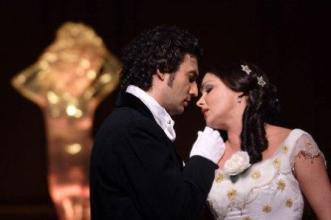Giuseppe Verdi – La Traviata (Royal Opera House 2008)
Giuseppe Verdi – La Traviata (Royal Opera House 2008)

01 Introduction 02 La traviata - Act 1 03 Set Change 04 La traviata - Act 2 Scene 1 05 Break before Act 2 Scene 2 06 La traviata - Act 2 Scene 2 07 Break before Act 3 08 La traviata - Act 3 09 Curtain Calls Act 1: 31 min Act 2 Scene 1: 44 min Act 2 Scene 2: 22 min Act 3: 36 min Violetta - Anna Netrebko Alfredo - Jonas Kaufmann Germont - Dmitri Hvorostovsky Flora Monika - Evelin Liiv Gastone - Ji-Min Park Baron Douphol - Eddie Wade Marquis D'Obigny - Kostas Smoriginas Dr. Grenvil - Mark Beesley Annina - Sarah Pring Giuseppe - Neil Gillespie Messenger - Charbel Mattar Servant - Jonathan Coad Conductor - Maurizio Benini 26 January 2008, ROYAL OPERA HOUSE, COVENT GARDEN
Anna Netrebko as Violetta, Jonas Kaufmann as Alfredo and Dmitri Hvorostovsky as Germont père: Covent Garden has certainly gone to town on the casting budget; this may be its tenth revival, but until now, Sir Richard Eyre's production of Verdi's La traviata for the Royal Opera hasn't been as lavishly cast since it was unveiled with Angela Gheorghiu and Leo Nucci in 1994. And the standing ovations at the end would seem to suggest that the performance had struck the ideal balance between the work's emotional weight and the technical demands required to carry it out.
However, although this was a memorable night, it was far from perfect. For me, the production does not deserve its reputation as one of the jewels in the company's crown, and in particular, Bob Crowley's sets do the piece few favours. In Act I, Violetta's salon is a kind of rotunda raised above the floor with stairs leading down either side. The chorus is cruelly cramped into the space so that there's no opportunity for an illustration of society whirling round Violetta's head as she succumbs to the delirium caused by her tuberculosis. I found it laughable when a single couple was seen dancing on the spot in the background during the scene between Alfredo and Violetta in the middle of the act, and the smaller (but crucial) characters were very difficult to distinguish amidst the crush. I also thought (as on previous occasions of seeing the production) the projected images of nineteenth-century ladies on the curtain during the Prelude were rather a missed opportunity - we could have had the contrast between the gaiety of Violetta's life and the tragedy of her consumption more tellingly illustrated, as they are in the music. Nor does the appearance of Violetta in a spotlight through the curtain add anything to the experience, where it might have immediately focussed the audience on the fact that she is dying; this would have come together nicely with the party scene that follows. Personally, I'd rather have nothing going on and be allowed just to listen to the drama in Verdi's music.--- Dominic McHugh, Musical Criticism
